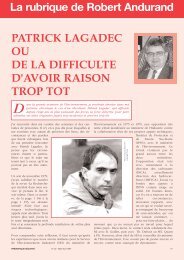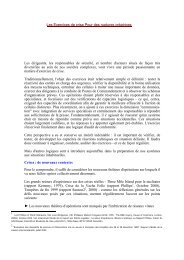STATES OF EMERGENCY - Patrick Lagadec
STATES OF EMERGENCY - Patrick Lagadec
STATES OF EMERGENCY - Patrick Lagadec
You also want an ePaper? Increase the reach of your titles
YUMPU automatically turns print PDFs into web optimized ePapers that Google loves.
Organizations with their backs to the wall 27appreciation of the phenomena in progress. Typical questions raised at thisstage (especially at night or during the weekend) are: "Should we bother thesafety manager?", "Should we warn the executive office?". Along the samelines, traditional organizational lethargy must be taken into account. If itweren't complex, a large-scale system could not function; but because it is so,information takes time to reach its destination. Otherwise the system must beshort-circuited, which cannot be a general operating procedure, because ofthe risk of creating bottlenecks and disorder. Of course the discerningorganization member can work around this barrier. But other mechanisms, ofa psychological nature, then come into play.When confronted with ambiguous or blatantly frightening realities,systems seize up. The slowest, most molasses-like movement is to be foundjust where snappy reactions are called for. As a rule, the more troubling thedata is, the farther it is from established norms, the slower and foggier itstransmission will be. If it is passed on pro forma, it will not be done soefficiently. The classic example is signaling an alert or a key piece ofinformation to a subordinate figure when it should be sent directly to a topmanager. The most deeply ingrained habit giving rise to problems of this sortis the tendency to stimulate each organizational level to "reassure" the levelsabove it. In 1976, as a result of such behavior, the chairman of Hoffmann-LaRoche was only called home from a business trip in the United States after theSeveso accident had already made the headlines in all the European media. Itwas too late.Isolation from the outside worldAn exceptional situation cries out for establishing very broad networks,but the opposite is what happens. The organization pulls in on itself, cuttingitself off from the outside world and even its most regularly used networks.The Taft chemical explosion is a fine example of this.Taft (Louisiana): around 11:00 pm on Friday, December 10, 1982, plant officials hadbecome sufficiently concerned to evacuate employees from a portion of the plant...There was an overheating problem with one of their tanks containing acrolein (a highlyvolatile chemical). Local emergency organizations in this chemical producing regionwere well-equipped to handle such emergencies, but were not contacted by plantofficials. The sheriffs office started to receive calls from individual citizens askingabout evacuation routes. What evacuation? Phone calls to the plant produced littlefurther information. "Nobody was telling us anything," as one official put it. Plantofficials continued to say that the situation was of "no danger to the public," until amessage arrived from the plant manager recommending the evacuation of all personswithin a five mile radius. The overheating tank exploded (it was near five other tanksicontaining acrolein). Quickly the situation escalated: some 17.000 persons wereevacuated, and traffic on the Mississippi River was stopped along a 12-mile safetyzone, while public officials were kept almost totally ignorant of the explosion situationand how it could evolve.Sophisticated physical means existed for early warnings (such as a hotline systembetween emergency centers and the dangerous plants in the zone). Public emergency
















